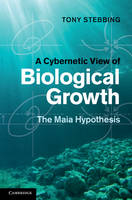
A Cybernetic View of Biological Growth
Cambridge University Press (Verlag)
978-0-521-19963-6 (ISBN)
Maia is the story of an idea, and its development into a working hypothesis, that provides a cybernetic interpretation of how growth is controlled. Growth at the lowest level is controlled by regulating the rate of growth. Access to the output of control mechanisms is provided by perturbing the growing organism, and then filtering out the consequences to growth rate. The output of the growth control mechanism is then accessible for interpretation and modelling. Perturbation experiments have been used to provide interpretations of hormesis, the neutralization of inhibitory load and acquired tolerance to toxic inhibition, and catch-up growth. The account begins with an introduction to cybernetics covering the regulation of growth and population increase in animals and man and describes this new approach to access the control of growth processes. This book is suitable for postgraduate students of biological cybernetics and researchers of biological growth, endocrinology, population ecology and toxicology.
Tony Stebbing joined the Plymouth Marine Laboratory when it was founded in 1971, and spent his career there. He worked initially to develop bioassay techniques for pollution studies. His later discovery of the stimulatory effect of low concentrations of toxic substances ('hormesis') led him to establish for the first time a method to access the output of growth control mechanisms. The coordination of scientific programmes occupied the later years of his career, and he holds an Honorary Fellowship from PML, which has provided the opportunity to write an account of his research and its implications.
Preface; 1. Maia - the argument in outline; 2. Growth unlimited - growth as a biological explosion; 3. Self-regulating systems - from machine to man; 4. The wealth of homeodynamic responses; 5. A cybernetic approach to growth analysis; 6. A control mechanism for Maia; 7. The three-fold way of adaptation; 8. Population growth and its control; 9. Hierarchy - a controlled harmony; 10. The historical origins of hormesis; 11. Maian mechanisms for hormesis and catch-up growth; 12. Cellular growth control and cancer; 13. Overpopulation; 14. Our finite Earth; 15. The Maia hypothesis and anagenesis; Glossary; References; Index.
| Erscheint lt. Verlag | 16.12.2010 |
|---|---|
| Zusatzinfo | 7 Tables, black and white; 15 Halftones, black and white; 101 Line drawings, black and white |
| Verlagsort | Cambridge |
| Sprache | englisch |
| Maße | 159 x 234 mm |
| Gewicht | 850 g |
| Themenwelt | Studium ► 1. Studienabschnitt (Vorklinik) ► Physiologie |
| Naturwissenschaften ► Biologie ► Biochemie | |
| Naturwissenschaften ► Biologie ► Genetik / Molekularbiologie | |
| Naturwissenschaften ► Biologie ► Zellbiologie | |
| ISBN-10 | 0-521-19963-8 / 0521199638 |
| ISBN-13 | 978-0-521-19963-6 / 9780521199636 |
| Zustand | Neuware |
| Haben Sie eine Frage zum Produkt? |
aus dem Bereich


